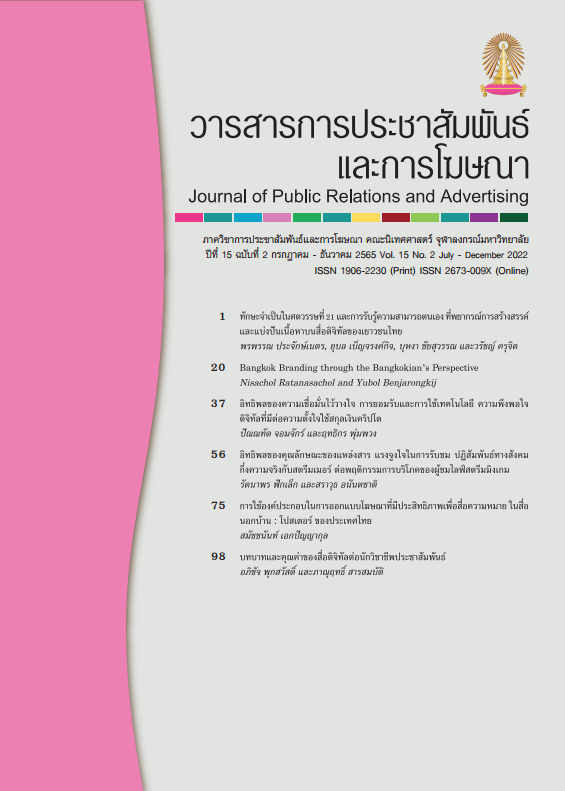The Role and The Value of Digital Media for PR Practitioner
Main Article Content
Abstract
The research aimed to investigate the use of digital media for PR practitioner, explain the elements of the role of PR practitioner in the context of digital media, and analyze the elements of the value of digital media towards PR practitioner. The research employs a methodology with data being analyzed quantitatively. A sample of 400 PR practitioners was purposively selected form PR Executive, PR practitioner and digital marketing communicator using both purposive and snowball samplings. In terms of exploratory factor analysis, the elements of role of PR practitioner in the context of digital media were categorized into 4 groups: 1) role of change management 2) role of corporate communication 3) role of expertise and 4) role of situational management. The value of digital media to promote knowledge and understanding of PR practitioner were classified 4 groups: 1) to know and understand digital media 2) to know and understand concept & theory of PR digital media 3) to handle digital media knowledge management and 4) to apply digital media to perform PR operations. The value of digital media to promote PR practitioner’s ideas were classified 2 groups: 1) to foster creativity and 2) to foster strategic thinking. The value of digital media to promote practitioner’s skills were classified 2 groups: 1) PR operations skill and 2) message design and media production skill. The value of digital media to promote PR practitioner’s talent promotion were classified 2 groups: 1) to promote to be digital media executive and 2) to promote to be PR Executive.
Article Details
References
กุลธิดา ธรรมวิภัชน์. (2543). ความเป็นนักวิชาชีพของนักประชาสัมพันธ์กับบทบาทและลักษณะการดำเนินงานประชาสัมพันธ์ในประเทศไทย. วารสารนิเทศศาสตร์, 18(2), 1-27.
พนม คลี่ฉายา. (2558). แนวโน้มวิชาชีพ หลักสูตร และคุณสมบัติพึงประสงค์ของบัณฑิตสาขาวิชาการประชาสัมพันธ์. วารสารการประชาสัมพันธ์ และการโฆษณา, 8(2), 31-54.
ยุบล เบ็ญจรงค์กิจ. (2551). คุณสมบัติของนักประชาสัมพันธ์และปัจจัยในการเลือกรับเข้าทำงานขององค์กรธุรกิจในประเทศไทย. วารสารการประชาสัมพันธ์และการโฆษณา, 1(2), 69-80.
รุ่งนภา พิตรปรีชา (2560). พลังแห่งการประชาสัมพันธ์. กรุงเทพมหานคร: บริษัท 21 เซ็นจูรี่จำกัด.
สถาบันการประชาสัมพันธ์ กรมประชาสัมพันธ์. (2563). เอกสารโครงการฝึกอบรมกลยุทธ์การประชาสัมพันธ์. กรุงเทพมหานคร: กรมประชาสัมพันธ์
สุนิสา ประวิชัย (2560). กลยุทธ์การประชาสัมพันธ์ผ่านสื่อสังคมออนไลน์. วารสารอิเล็กทรอนิกส์การเรียนรู้ทางไกลเชิงนวัตกรรม, 7(2), 1-13.
สำนักงานสภาพัฒนาการเศรษฐกิจและสังคมแห่งชาติ. (2564). ร่างแผนพัฒนาเศรษฐกิจและสังคมแห่งชาติฉบับที่ 13 (พ.ศ. 2566-2570). กรุงเทพมหานคร: สำนักงานสภาพัฒนาการเศรษฐกิจและสังคมแห่งชาติ.
อภิชัจ พุกสวัสดิ์. (2561). รายการวิจัยการสำรวจสถานภาพการดำเนินงานประชาสัมพันธ์ผ่านการสื่อสารเครือข่ายสังคมออนไลน์ขององค์กรธุรกิจเอกชนในเขตกรุงเทพมหานคร. สมุทรปราการ: คณะนิเทศศาสตร์ มหาวิทยาลัยหัวเฉียวเฉลิมพระเกียรติ.
Alexander, D. (2004). Changing The PR Curriculum: A New Challenge for Education. Prism 2(1), 1-7.
Broom, Glen M. (1982). A comparison of Sex Roles in PR. Public Relations Review, 8(3), 17-22.
Cochran, W.G. (1953). Sampling Techniques. New York: John Wiley & Sons. Inc.
Fitch, K. (2009). Making Friends in the Wild West: Singaporean Public Relations Practitioners’ Perceptions of Working in Social Media, Prism, 6(2), 1–10.
Flew, T. (2008). New Media: An Introduction. South Melbourne: Oxford University Press.
Grunig, J.E. (2009). Paradigms of Global Public Relations in an Age of Digitalization; Prism, 6(2), 1-19.
Holtz, S. (2002). Public relations on the Net. New York: AMACOM.
Morre, S. (2000). Media and Everyday Life in Modern Society. Edinburgh: Oxford University Press.
Knapp, M. and Daly, J. (2005). Handbook of Interpersonal Communication. Los Angeles: Sage.
Pallant, J. (2001). SPSS Survival Manual a Step by Step Guide to Data Analysis Using SPSS for Windows Version 10. Buckingham Open University Press.
Pavlik, J. (2007). Mapping the Consequences of Technology on Public Relations. Florida: The Institute of Public Relations.
Philips, D. and Young, P. (2010). Online Public Relations. London: Kogan Page.
Solis, B. and Breakenridge, D. (2012). Putting the Public Relations Back in Public Relations: How Social Media is Reinventing the Aging Businesses of PR. Upper Saddle River, NJ: Pearson Education.
Tench, R. and Yeoman, L. (2006). ‘What Next? Future Issues for Public Relations’ in Tench and Yeoman. Exploring Public Relations. London: FT/Prentice Hall.
Thurlow, C.; Lengel, L. & Tomic, A. (2004). A Computer Mediated Communication: Social Interaction and Internet. London: Sage.
Ulla, B. (1998). An international communication perspective on professional Internet Usage: A Survey of PR practitioners’ Usage of Internet in Australia. Belgium, France, Germany the Netherlands, Sweden and the United Kingdom with Comparisons to the USA. Unpublished Master Thesis, University of South Alabama.
Wiersma, W. (1995). Research Method in Education: An Introduction. USA: Allyn and Bacon.
Wilcox, D.L. (2006). The Landscape of Today’s Global PR. Anlisi, 34, 67-85.


